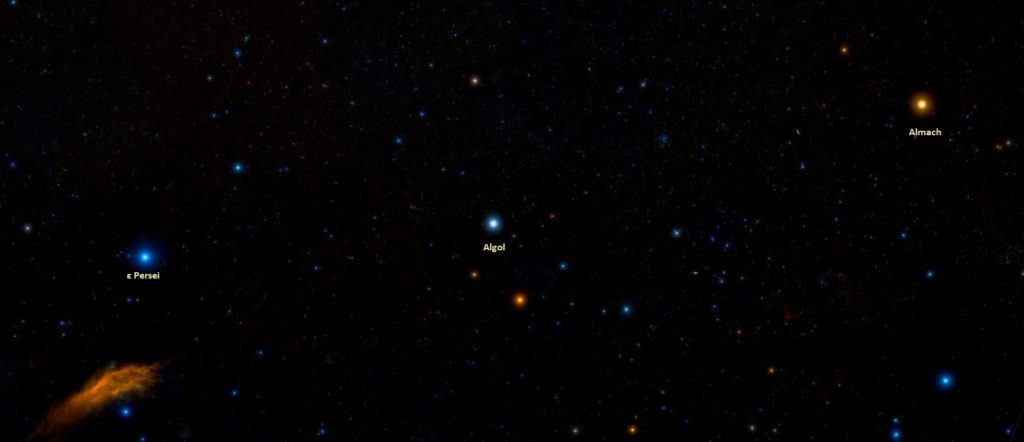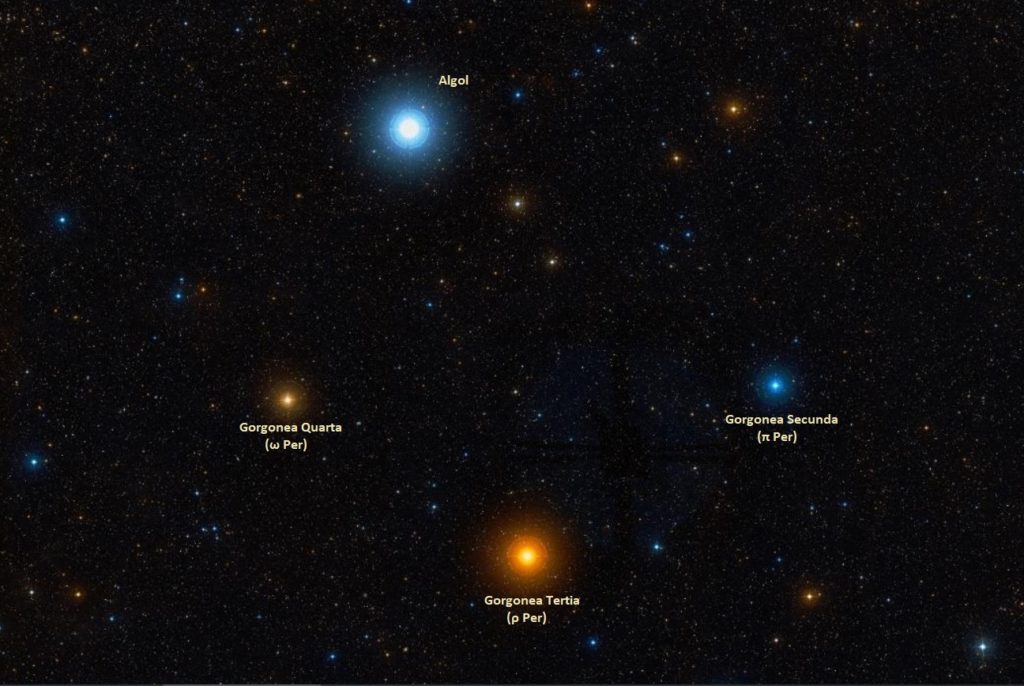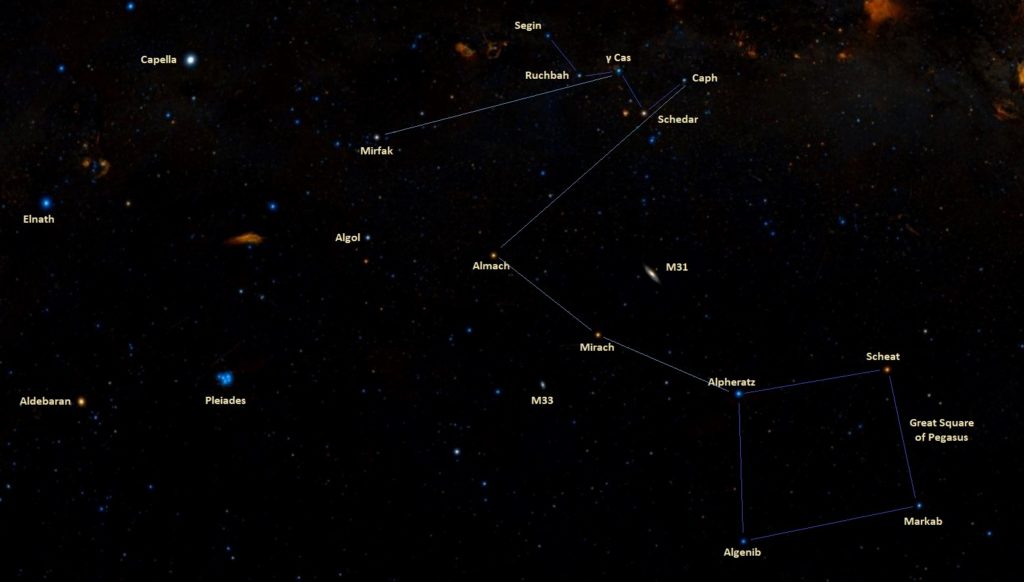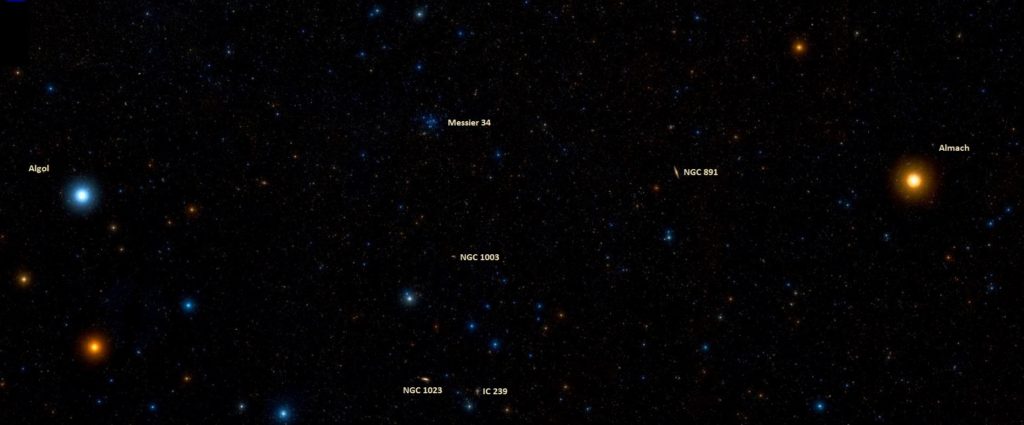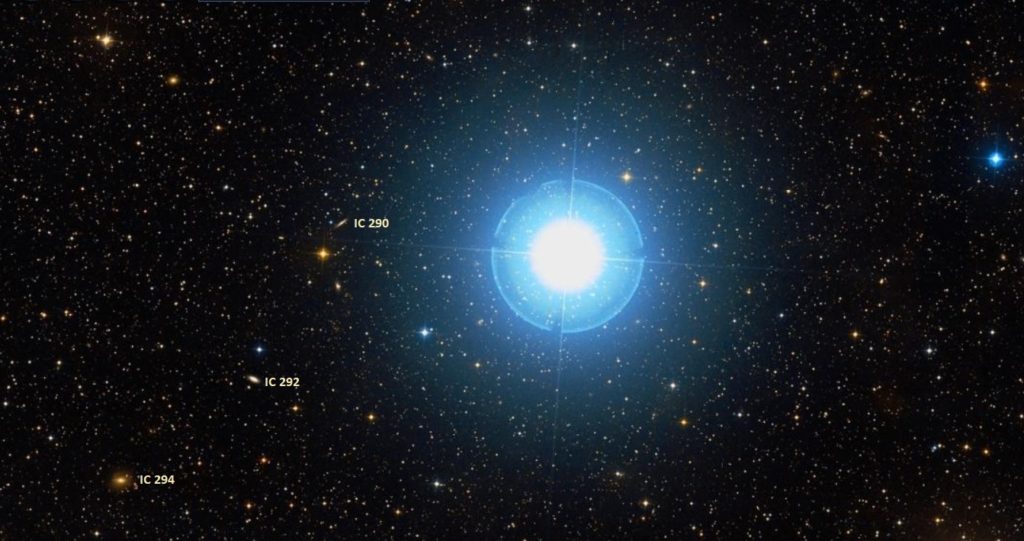Algol, Beta Persei (β Per) is a triple star system located in the constellation Perseus. Commonly known as the Demon Star, it is one of the best-known variable stars in the sky and a prototype for a class of eclipsing variable stars known as Algol variables. With an apparent magnitude of 2.12, Algol is the second brightest star in Perseus, after Mirfak. It lies at a distance of 90 light years from Earth.
In Perseus, Algol marks the head of the Gorgon Medusa, a mythical monster associated with the myth of Perseus, who used her head to turn his enemies to stone.
Star system
Beta Persei is a triple star system consisting of Beta Persei Aa1, a hot blue-white main sequence star of the spectral type B8V, Beta Persei Aa2, a cooler orange subgiant with the stellar classification K0IV, and Beta Persei Ab, a white star of the spectral type A7m. The components are sometimes referred to as Beta Persei A, B, and C.
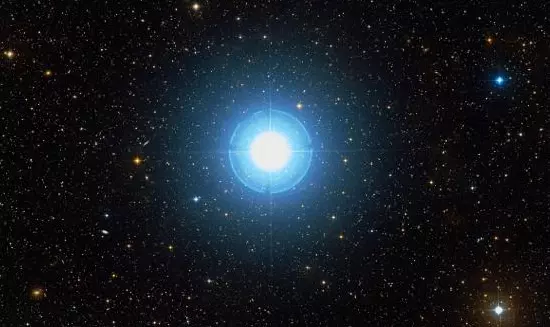
Algol (Beta Persei), image: Wikisky
The components Aa1 and Aa2 regularly eclipse each other during their orbit, causing the system’s overall brightness to drop.
Most of the time, the Beta Persei system has a visual magnitude of 2.1, but its brightness fades to magnitude 3.4 every 2.867328 days, when the larger but fainter orange subgiant star passes in front of the brighter primary component. This is the primary minimum of the system.
The partial eclipses last about 10 hours. They can be tracked by comparing Algol’s brightness to that of Almach in the neighbouring constellation Andromeda and Epsilon Persei in Perseus. At its usual brightness, Algol is slightly brighter than Almach (mag. 2.27). During the primary eclipses, it grows fainter than Epsilon Persei (mag. 2.88).
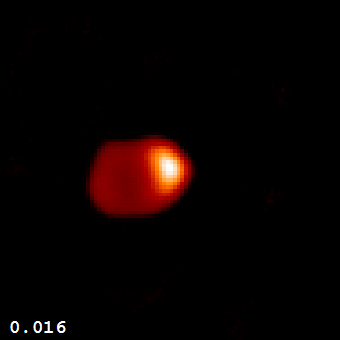
Algol (β Persei) is a triple-star system (Algol A, B, and C) in the constellation Perseus, in which the large and bright primary Algol A is regularly eclipsed by the dimmer Algol B every 2.87 days. The eclipsing binary pair is separated by only 0.062 astronomical units (AU) from each other, so close in fact that Algol A is slowly consuming the less massive Algol B by continually stripping off Algol B’s outer layers. This animation was assembled from 55 images of the CHARA interferometer in the near-infrared H-band, sorted according to orbital phase. Because some phases are poorly covered, B jumps at some points along its path. The phase of each image is indicated at the lower left. The images vary in quality, but the best have a resolution of 0.5 milliarcseconds, or approximately 200 times better than the Hubble Space Telescope. (A milliarcsecond is about the size of a quarter atop the Eiffel Tower as seen from New York City.) Tidal distortions of Algol B giving it an elongated appearance are readily apparent. Tidal distortions also result in “gravity darkening” effects, whereby in a significant number of images of Algol B, the edge or “limb” of the image is actually brighter than the center. Image: Dr. Fabien Baron, Dept. of Astronomy, University of Michigan, Ann Arbor, MI 48109-1090 (CC BY-SA 3.0)
The secondary eclipses occur when the primary component eclipses the fainter star, but these are very shallow and, unlike primary eclipses, which can be seen by the unaided eye, they can only be detected photoelectrically.
Beta Persei Aa1 has a mass 3.17 times that of the Sun and a radius 2.73 times solar. With a surface temperature of 13,000 K, it is 182 times more luminous than the Sun. The star spins considerably faster than the Sun, with a projected rotational velocity of 49 km/s. Its estimated age is 570 million years.
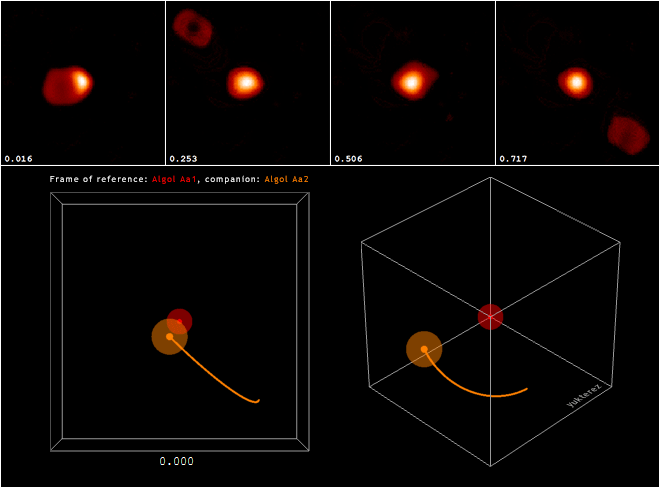
Interpolation of the orbit of Beta Persei Aa2 around Aa1 with focus on Aa1. Photos taken with the CHARA interferometer in the near-infrared H-band. Image: Wikimedia Commons/Simon Tyran (CC BY-SA 4.0)
Beta Persei Aa2 is less massive than the Sun, with 0.70 solar masses, but has expanded to a size of 3.48 solar radii as it has evolved away from the main sequence. With an effective temperature of 4,500 K, the star shines with 6.92 solar luminosities.
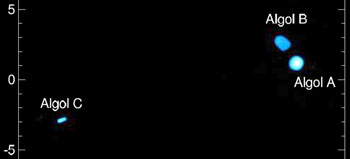
The Algol system as it appeared on 12 August 2009. This is not an artistic representation, but rather is a true two-dimensional image with 1/2 milli-arcsecond resolution in the near-infrared H-band, reconstructed from data of the CHARA interferometer. The elongated appearance of Algol B and the round appearance of Algol A are real. The form of Algol C, however, is an artifact. Image: Dr Fabien Baron, Dept. of Astronomy, University of Michigan, Ann Arbor, MI 48109-1090 (CC BY-SA 3.0)
Beta Persei Aa1 and Aa2 are separated by only 0.062 astronomical units – that is only 6.2% of the distance between the Sun and Earth – while the third component, Beta Persei Ab, orbits the main pair with a period of 680.08 days at an average distance of 2.69 astronomical units.
Beta Persei Ab has 1.76 solar masses and a radius 1.73 times that of the Sun. It has an effective temperature of 7,500 K and is 10 times more luminous than the Sun.
The Washington Double Star Catalog lists two other companions, designated Beta Persei B and C, about one arcminute away. Five other faint stars are also listed as companions.
Algol paradox
Observations of Algol have challenged the basic theories of stellar evolution. A fundamental belief is that the more massive the star, the faster it evolves, leaves the main sequence and expands into a subgiant or giant. In a binary star system, components form at about the same time. In the case of Beta Persei, the less massive star – the secondary component – has already evolved into a subgiant, while the considerably more massive primary component is still on the main sequence.
The paradox is explained by mass transfer, a common occurrence in close binary systems, in which the flow of material between the stars disrupts the normal process of evolution. The star that was originally more massive – now a class K subgiant – has filled its Roche lobe and transferred much of its mass onto the companion, all the while evolving and reaching the next stage faster. Meanwhile, the companion has accreted the mass but stayed on the main sequence.
Algol variables
Algol is a prototype for a class of eclipsing variable stars known as Algol variables. These are semidetached binary star systems consisting of a main sequence star and a cooler, more evolved secondary component that fills its Roche lobe.

Schematic of a binary star system in a semidetached configuration with a mass ratio q=3, viewed at an inclination of 90 degrees (edge on). The filled regions represent the two stars. The black line represents the inner critical Roche equipotential, made up of two Roche lobes that meet at the Lagrangian point L1. In a semidetached configuration one star fills its Roche lobe. Image: Wikimedia Commons/Philip D. Hall (CC BY-SA 4.0)
Gas from the donor star is transferred to the companion and the mass transfer affects the evolution of the system. The inflowing gas often forms an accretion disk around the accreting companion. The gas flow between stars in these systems can sometimes be seen. It has been imaged in the Algol system using Doppler Tomography.
These systems vary in brightness when seen from Earth because their orbital plane is aligned with our line of sight. The periods between the primary eclipses are very regular and depend on the stars’ orbital periods. Most of these systems are close binary stars and take only a few days to complete an orbit. The system with the shortest period is HW Virginis with about 2:48 hours, and the one with the longest is Almaaz (Epsilon Aurigae), with 9,892 days (27 years).
The components of these systems are spherical or slightly ellipsoidal in shape, but not as heavily deformed by gravitational effects as Beta Lyrae variables and W Ursae Majoris stars. Beta Lyrae variables are binary stars that are so close together that their shapes are distorted into ellipsoidal and there is extensive mass flow in the systems, while W Ursae Majoris variables are contact binary systems that have a common envelope of material and transfer mass through a connecting neck.
Algol variables make up 9% of all variable stars. There are thousands of known systems that belong to this class. Other than Almaaz, the brighter members include Alphecca (Alpha Coronae Borealis), Wurren (Zeta Phoenicis), Lambda Tauri, and Alsephina (Delta Velorum).
Facts
Algol may have been the first variable star discovered. Studies published in 2008 and 2013 found evidence that the periodicity of the star was documented in Ancient Egyptian Calendars of Lucky and Unlucky Days, written 3,000 years ago, and that the period of Algol was 2.85 days. The periodicity was noted in the Cairo Calendar, the best preserved of these texts, dated to 1244 – 1163 BCE. The scribes described the repetitive change of the Eye of Horus, called “the Raging One” or “Wedjat,” from a peaceful to raging personality. A 2015 study confirmed that the descriptions of the actions of Horus were consistent with the periodicity of the star and that the Cairo Calendar was the oldest known historical document with a record of the discovery of a variable star.
In more recent times, Italian astronomer Geminiano Montanari has usually been credited for the discovery of Algol’s variability. Montanari noted that the star varied in brightness in 1667. The only non-nova variable star discovered before Algol was Mira, Omicron Ceti, identified by the Frisian astronomer Johannes Holwarda in 1638.
The 2.867-day period in the eclipses of Algol was discovered by the English amateur astronomer John Goodricke in 1783. Goodricke, who is also credited for the discovery of the periodic variations of Delta Cephei and Beta Lyrae (Sheliak), was the first to explain the mechanism of the variations, suggesting that Algol was what is now known as an eclipsing binary system. In a letter dated May 12, 1783, addressed to the Rev. Anthony Shepherd, Plumian Professor of Astronomy and Experimental Philosophy at Cambridge, Goodricke wrote:
If it were not perhaps too early to hazard even a conjecture on the cause of this variation, I should imagine it could hardly be accounted for otherwise than either by the interposition of a large body revolving around Algol, or some kind of motion of its own, whereby part of its body, covered with spots or such like matter, is periodically turned towards the earth.
Later that year, the Royal Society awarded Goodricke the Copley Medal for his discovery of periodicity of Algol. He was 19 years old at the time.
In 1881, almost a century later, American astronomer Edward Charles Pickering presented evidence that a body passing between the star and the observer would account for Algol’s variations in brightness.
In 1889, German astrophysicist Hermann Carl Vogel confirmed that Algol was a binary star. Vogel is credited for inventing the photographic-spectroscopic radial velocity measurements of stars and, in his work, he discovered that spectra of some stars shifted slightly toward the red and then toward the blue, indicating that the stars were moving toward and away from the Earth. The stars seemed to be orbiting around an unseen centre of mass, which suggested that they were binary systems, and the spectral shifts were caused by the Doppler effect. However, as the companions in these systems could not be resolved in a telescope, the systems were identified as spectroscopic binaries. Algol was one of the first such systems to be discovered.
In 1910, the American astronomer and photoelectric photometry pioneer Joel Stebbins used a selenium photometer to accurately measure the light of Algol and investigate the star’s light-curve. He found that the companion gave off more light than the Sun and was much brighter on the side facing the primary component.
Spectroscopic investigation of the system also revealed small, but periodic departures in the radial velocity curve of the primary component, indicating that there was at least one other companion in the system. The presence of the third star, suspected since 1912, was reported in 1939 and confirmed in 1957.
Algol came within 9.8 light years of the Sun 7.3 million years ago. At the time, it shone at magnitude -2.5, which is about a magnitude brighter than Sirius (mag. -1.47) is today. Because the Beta Persei system has a total mass of 5.8 solar masses, the system’s gravity may have disrupted the Oort cloud at its closest approach, possibly deflecting numerous comets into the inner solar system. However, a study published in 1999 showed that passing stars do not perturb the Oort cloud to such a degree as to cause a considerable increase in the number of comets near the Earth’s orbit. The Oort cloud, a theoretical spherical shell that surrounds the Sun, the planets in the solar system, and Kuiper Belt objects, consists mainly of icy planetesimals and lies at a distance of 2,000 to 200,000 astronomical units, or 0.03 to 3.2 light years, from the Sun.
The Beta Persei system shows X-ray and radio wave flares. Radio emissions in two eclipsing binary systems – Beta Persei and Beta Lyrae – were detected using the National Radio Astronomy (NRAO) interferometer in the 1970s. A study published in 1998 found a strong correlation between the X-ray activity and evolutionary stage in components of Algol-type binary systems. The X-ray flares are believed to be the result of the magnetic fields of the two components interacting with the mass transfer.
The longest-running continuous survey of radio flares in the Beta Persei system, conducted from January 1995 to October 2000, found a dominant periodicity of 48.9 ± 1.7 days, which suggests that strong flares occur approximately every 17 orbital cycles. The flares take 20 to 50 hours to rise and have decay times of 10 to 40 days.
A study published in 1993 used very-long-baseline interferometry (VLBI) to measure the displacement of the radio source in the Algol system and found that the nonthermal radio emission comes from the secondary component, the class K subgiant. It is believed to be related to the strong magnetic activity of the star.
The magnetic activity cycles of the subgiant and the mass transfer between the stars are believed to have an effect on the recurrent variations in the orbital period.
Like many other bright stars, Algol has often been used in the works of fiction, as well as in films, television, and games. Memorable uses include the short stories “Beyond the Wall of Sleep” (1919) by H. P. Lovecraft and “Neither Brute Nor Human” (1984) by Isaac Asimov, the novels The Sorrows of Satan (1895) by Marie Corelli, The Hitchhiker’s Guide to the Galaxy (1979) by Douglas Adams, and David S. Garnett’s Stargonauts (1994) and Bikini Planet (2000), the silent film Algol (1920) directed by Hans Werckmeister, and the episodes “Ménage à Troi” (1990) and “Qpid” (1991) of Star Trek: The Next Generation.
Algol in astrology
In astrology, Algol is considered one of the most unfortunate stars. Medieval astrologers counted it among the 15 Behenian fixed stars, which were believed to be a source of special influence on one or more planets and considered useful for magical applications. Each star was associated with a plant and gemstone, which would be used to draw the star’s power. Algol was believed to be a source of astrological power for the planets Jupiter and Saturn. It was associated with diamond and black hellebore.
Ancient Egyptians used Algol to make their prognoses in Calendars of Lucky and Unlucky Days more than 3,000 years ago.
The Alexandrian astronomer Claudius Ptolemy called the star “the Gorgon of Perseus” in his Tetrabiblos, a text on astrology written in the 2nd century CE. Ptolemy associated the star with decapitation, which reflects the myth of Medusa’s end.
In medieval times, Arabic commanders avoided going into battle when Algol was at its dimmest.

The kabbalistic symbol “Caput Algol” corresponding to Algol (β Persei), a star in the Perseus’ constellation. Originally described in Libri tres de occulta philosophia (1531) by Heinrich Cornelius Agrippa. Image: Wikimedia Commons/Selket (CC BY-SA 3.0)
The 16th century German scholar and occult writer Heinrich Cornelius Agrippa, who wrote about the Behenian stars in his Three Books of Occult Philosophy (1531), called Algol Caput Larvæ and used a kabbalistic symbol that was also used on Arabic talismans for protection against enemies and curses.
Agrippa wrote, “Under the Head of Algol, they made an image whose figure was the head of a man with a bloody neck; they report that it bestoweth good success to petitions, and make him go carrieth it bold and magnanimous, and preserveth the members of the body sound; also it helpeth against witchcraft, and reflecteth evil endeavours, and wicked incantations upon our adversaries.”
Name
The name Algol (pronunciation: /ˈælɡɒl/) comes from the Arabic phrase raʾs al-ghūl, meaning “the head of the ogre.” Al Ghul originally meant “mischief-maker.”
The name was officially approved by the International Astronomical Union’s (IAU) Working Group on Star Names (WGSN) on June 30, 2016. It formally applies only to the component Beta Persei Aa1.
Algol has also been commonly known as the Demon Star, Gorgona, Gorgonea Prima, the Ghoul, the Blinking Demon, and the Spectre’s Head.
The Chinese know Algol as 大陵五 (Dà Líng wu), the Fifth Star of Mausoleum. The Chinese Mausoleum asterism is formed by Algol with 9 Persei, Tau Persei, Iota Persei, Misam (Kappa Persei), Rho Persei, 16 Persei, and 12 Persei. Mausoleum is part of the Stomach mansion, which represents the body of the White Tiger.
Demon Star
Algol has been associated with demons, monsters and similar creatures across different cultures throughout history. The Greeks associated the star with the Gorgon Medusa, a mythical creature with hair made of snakes and a face so horrifying that it turned those who looked at it to stone.
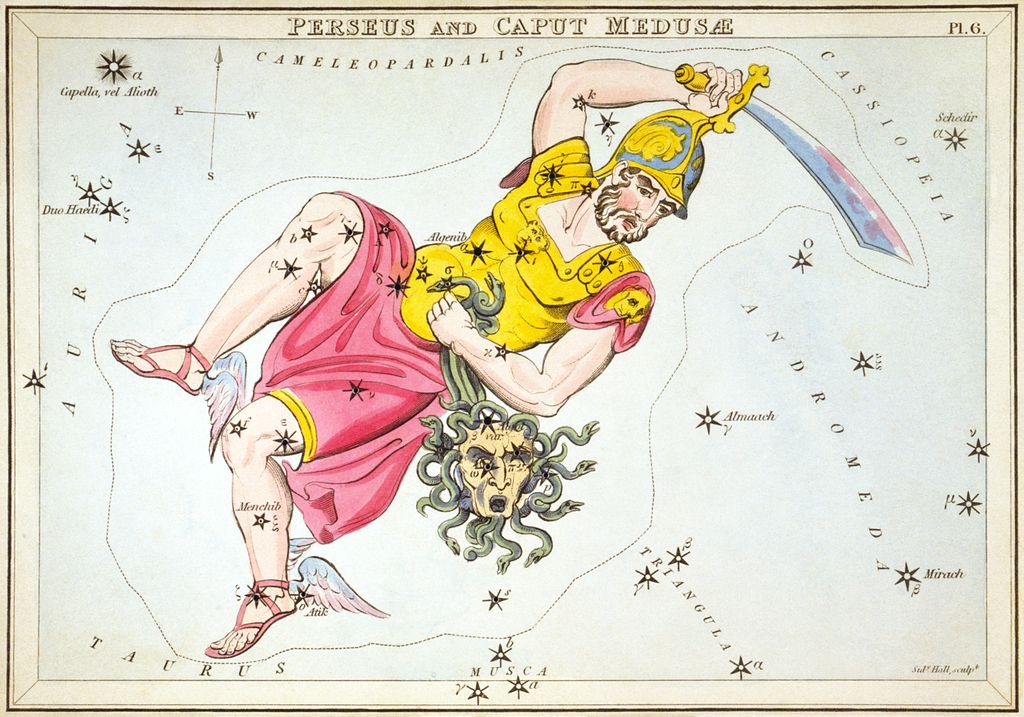
Perseus and Caput Medusæ, plate 6 in Urania’s Mirror (1824), a set of 32 astronomical star chart cards based on Alexander Jamieson’s A Celestial Atlas, engraved by Sidney Hall
Ptolemy called the star ton en gorgonio o lampros, meaning “the bright one of those in the Gorgon head.” The three fainter stars he described as lying in the Gorgon’s head were Pi, Rho and Omega Persei. These stars are traditionally known as Gorgonea Secunda (Pi Persei), Gorgonea Tertia (Rho Persei), and Gorgonea Quarta (Omega Persei), while Algol is called Gorgonea Prima. Hipparchus (c. 190 – c. 120 BCE) and Pliny the Elder (23/24 – 79 CE) created a separate constellation of these stars and called it the Head of Medusa.
In the 17th, 18th, and 19th centuries, the four stars appeared on several maps as a sub-constellation called Caput Medusae, also meaning “the head of Medusa.”
In Arabic tradition, the star represented the head of the ghoul, which is reflected in its name. The star’s Hebrew name was Rōsh ha Sāṭān, “the head of Satan.” The star was also associated with Lilith, Adam’s first wife.
In the 16th century, a Latin name for Algol was Caput Larvae, meaning “the spectre’s head.”
In his Star Names: Their Lore and Meaning (1899), Richard Hinckley Allen notes that Algol had the Chinese name Tseih She (叠尸,Dié Shī), meaning “piled up corpses.” However, the name really belongs to Pi Persei (Gorgonea Secunda), the sole star of the 積屍 (Jī Shī) asterism, representing “Heaps of Corpses.”
Location
Algol is easy to find because it lies in a region of the sky that contains a number of bright stars that form identifiable patterns. Algol forms a triangle with Mirfak, the brightest star in Perseus, and Almach, the third brightest star in Andromeda. These two stars can be found using the two prominent northern asterisms: the Great Square of Pegasus and Cassiopeia’s W.
Andromeda’s brightest stars – Alpheratz, Mirach and Almach – form a chain that connects the constellations Pegasus and Perseus. Alpheratz marks the top left corner of the Great Square of Pegasus, also formed by Markab, Scheat and Algenib. Mirach, the middle star in the chain, is commonly used to find the Andromeda Galaxy (Messier 31) and the Triangulum Galaxy (Messier 33). Almach, the third star in the chain, lies roughly on the imaginary line extended from Caph (Beta Cassiopeiae) through Schedar (Alpha Cassiopeiae), the rightmost stars of Cassiopeia’s W.
Mirfak can be found by extending the chain of three bright stars of Andromeda or by extending the line from the two inner stars of Cassiopeia’s W – Gamma Cassiopeiae and Ruchbah (Delta Cassiopeiae). The star lies just north of the imaginary line connecting Almach and the bright Capella in the constellation Auriga.
Algol and Almach can be used to find several bright deep sky objects that lie in the region between the two stars. These are the open cluster Messier 34 (mag. 3.4), the edge-on unbarred spiral galaxy NGC 891 (the Silver Sliver Galaxy, mag. 10.8), the spiral galaxy NGC 1003 (mag. 11.2), the spiral galaxy IC 239 (mag. 12.1), and the barred lenticular galaxy NGC 1023 (mag. 10.35).
Three fainter galaxies lie in the same field of view as Algol: the spiral galaxies IC 290 and IC 292, and the lenticular galaxy IC 294.
Constellation
Algol is located in the constellation Perseus. Perseus is the 24th largest constellation in the sky, stretching across an area of 615 square degrees of the northern sky between Auriga, Taurus, Aries, Triangulum, Andromeda, Cassiopeia and Camelopardalis. Representing the mythical Greek hero, it is one of the Greek constellations, first listed by the Greek astronomer Ptolemy in the 2nd century CE. Perseus is traditionally depicted carrying the head of the Gorgon Medusa, represented by Algol.
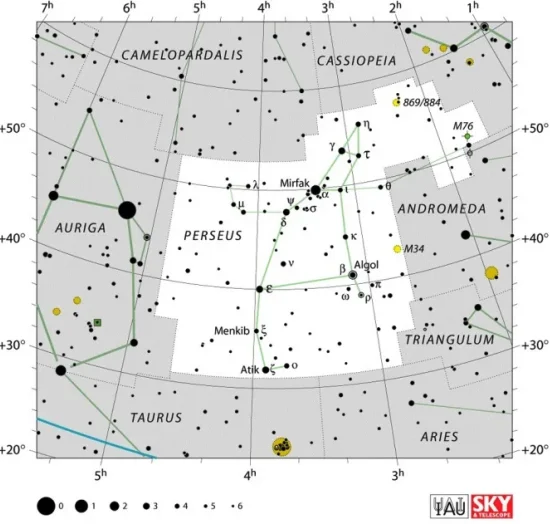
Perseus constellation map by IAU and Sky&Telescope magazine
Perseus is best-known for containing the radiant of the annual Perseid meteor shower, which peaks in mid-August. The constellation is also home to a number of notable deep sky objects. These include the Alpha Persei Cluster, a magnitude 1.2 open cluster centred on Mirfak, the open clusters Messier 34 and the Double Cluster (NGC 869 and NGC 884), the emission nebula NGC 1499, also known as the California Nebula, the planetary nebula Messier 76 (the Little Dumbbell Nebula), and the Seyfert galaxy NGC 1275 (Perseus A), the central member of the Perseus Cluster of galaxies.
The best time of year to see the stars and deep sky objects in Perseus is during the month of December.
The 10 brightest stars in Perseus are Mirfak (Alpha Per, mag. 1.806), Algol (Beta Per, mag. 2.09), Zeta Persei (mag. 2.86), Epsilon Persei (mag. 2.88), Gamma Persei (mag. 2.93), Delta Persei (mag. 3.01), Rho Persei (mag. 3.39), Miram (Eta Per, mag. 3.79), Nu Persei (mag. 3.80), and Misam (Kappa Per, mag. 3.80).
Algol – Beta Persei
| Spectral class | B8V (Aa1), K0IV (Aab), A7m (Ab) |
| Variable type | EA/SD (semi-detached Algol-type eclipsing binary) |
| U-B colour index | −0.37 |
| B-V colour index | −0.05 |
| Apparent magnitude | 2.12 (- 3.39) |
| Distance | 90 ± 3 light years (28 ± 1 parsecs) |
| Parallax | 36.27 ± 1.40 mas |
| Radial velocity | 3.7 km/s |
| Proper motion | RA: 2.99 mas/yr |
| Dec.: -1.66 mas/yr | |
| Constellation | Perseus |
| Right ascension | 03h 08m 10.1324535s |
| Declination | +40° 57′ 20.328013″ |
| Names and designations | Algol, Gorgonea Prima, Gorgona, Demon Star, Beta Persei, β Per, 26 Persei, HD 19356, HR 936, HIP 14576, SAO 38592, PPM 45864, FK5 111, BD+40°673, GC 3733, GCRV 1731, GJ 9110, ADS 2362 A, CCDM J03082+4057A, EUVE J0308+40.9, IDS 03017+4034 A, IRAS 03048+4045, 2MASS J03081012+4057204, PLX 646, TYC 2851-2168-1, AAVSO 0301+40, WDS J03082+4057Aa,Ab |
Beta Persei Aa1
| Spectral class | B8V |
| Absolute magnitude | -0.07 |
| Mass | 3.17 ± 0.21 M☉ |
| Luminosity | 2.73 ± 0.20 L☉ |
| Radius | 182 R☉ |
| Temperature | 13,000 K |
| Age | 570 million years |
| Rotational velocity | 49 km/s |
| Surface gravity | 4.0 cgs |
Beta Persei Aa2
| Spectral class | K0IV |
| Absolute magnitude | 2.9 |
| Mass | 0.70 ± 0.08 M☉ |
| Luminosity | 6.92 L☉ |
| Radius | 3.48 ± 0.28 R☉ |
| Temperature | 4,500 K |
| Surface gravity | 3.5 cgs |
Beta Persei Ab
| Spectral class | A7m |
| Absolute magnitude | 2.3 |
| Mass | 1.76 ± 0.15 M☉ |
| Luminosity | 10.0 L☉ |
| Radius | 1.73 ± 0.33 R☉ |
| Temperature | 7,500 K |
| Surface gravity | 4.5 cgs |
